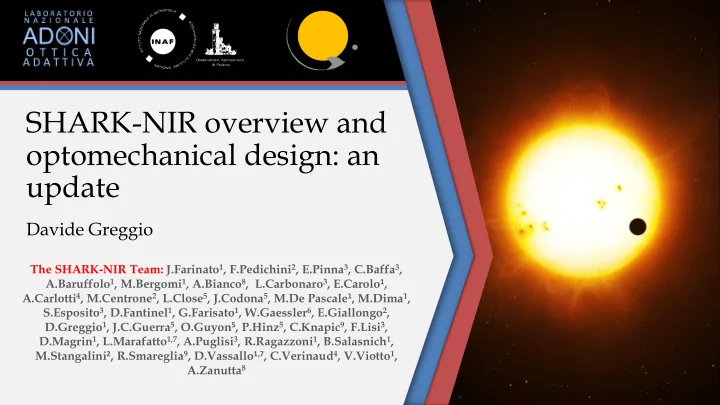

SHARK-NIR overview and optomechanical design: an update Davide Greggio The SHARK-NIR Team: J.Farinato 1 , F.Pedichini 2 , E.Pinna 3 , C.Baffa 3 , A.Baruffolo 1 , M.Bergomi 1 , A.Bianco 8 , L.Carbonaro 3 , E.Carolo 1 , A.Carlotti 4 , M.Centrone 2 , L.Close 5 , J.Codona 5 , M.De Pascale 1 , M.Dima 1 , S.Esposito 3 , D.Fantinel 1 , G.Farisato 1 , W.Gaessler 6 , E.Giallongo 2 , D.Greggio 1 , J.C.Guerra 5 , O.Guyon 5 , P.Hinz 5 , C.Knapic 9 , F.Lisi 3 , D.Magrin 1 , L.Marafatto 1,7 , A.Puglisi 3 , R.Ragazzoni 1 , B.Salasnich 1 , M.Stangalini 2 , R.Smareglia 9 , D.Vassallo 1,7 , C.Verinaud 4 , V.Viotto 1 , A.Zanutta 8
WHY SHARK Considering: We proposed to build: a simple camera (compact, light, close • The excellent AO performance • to the WFS) designed for high contrast • The current and next generation imaging LBT instruments scenario working in VIS and NIR bands • • The Northern Emisphere scenario capable to do: • • The strong science case Coronagraphy • Direct Imaging • • The wish to make a fast track project LR Spectroscopy •
WHAT IS SHARK? SHARK-NIR Coronagraphic camera with spectroscopic capabilities Extreme adaptive optics correction of FLAO Synergy with other LBT instruments: SHARK-VIS, LMIRCam Pyramid Pyramid WFS WFS SHARK SHARK LMIRCam NIR VIS K; L; M J; H R; I LSS SHARK-VIS SHARK-NIR R~100 R~1000
SHARK POSITION AT LBT Photo credit: LBTO - Enrico Sacchetti LINC-NIRVANA SHARK-VIS SHARK-NIR LBTI LUCI
SHARK – SCIENCE TARGETS Main science target: direct imaging of exo-planets (detection and characterization) Other science: • Brown dwarfs • Protoplanetary disks • Stellar jets • AGN
INSTRUMENT SPECIFICATIONS SHARK NIR main characteristics Observing Modes Imaging/Coronagraphy/Spectroscopy/DBI Detector format [px] 2048x2048 (≈1220x1220 used area) 0.96 – 1.7 Waveband [ μ m] FoV x ["] 18 FoV y ["] 18 25.5 FoV along the diagonal ["] Plate scale [mas/px] 14.5 Airy Radius @ 0.96 micron [px] 2 8 (3 flat, 1DM and 4 OA parabolas) # of mirrors in the camera ADC Yes Nominal Strehl at <18’’ FoV diameter >98% (in all Bands)
OPTO-MECHANICAL LAYOUT Optical bench + Cryostat SHARK Holding structure
OPTO-MECHANICAL LAYOUT
CORONAGRAPHY IN SHARK 1 st pupil 2 nd pupil Science Intermediate plane focal plane focal plane plane Apodizer, Scientific Star occulter Lyot stop shaped pupil image Lyot stop occulter I(x) I(x) I(x) I(x) x x Weak x x Weak companion companion
CORONAGRAPHIC TECHNIQUES Gaussian Lyot Shaped pupil (both symmetric and asymmetric discovery space) APLC/4 Quadrant (?) Field stabilized mode (de-rotator ON) requires circular symmetric masks (Classical Lyot and Gaussian Lyot). Shaped Pupil and APLC are used in Pupil stabilized mode (de-rotator OFF)
CORONAGRAPHIC PERFORMANCE 5- σ detection limit in H band for Rmag=8 with SOUL Seeing 0.4” Seeing 0.6”
SHARK – OPTICAL LAYOUT beam splitter to apodizer the tip-tilt WFS ADC Tip-tilt mirror off-axis parabola off-axis parabola Pupil lens (deployable) off-axis detector cryostat parabola window ~300 mm incoming off-axis light parabola occulters and slit cold baffle fold mirror Narcissus mirror fold mirror fold mirror Science filter Lyot stop, wheels GRISM
SHARK – OPTICAL LAYOUT beam splitter to apodizer the tip-tilt WFS ADC Tip-tilt mirror off-axis Coronagraphic parabola planes off-axis parabola Pupil lens (deployable) off-axis detector cryostat parabola window ~300 mm incoming off-axis light parabola occulters and slit cold baffle fold mirror Narcissus mirror fold mirror fold mirror Science filter Lyot stop, wheels GRISM
tip-tilt sensor SHARK – OPTICAL LAYOUT Closed loop beam splitter to apodizer the tip-tilt WFS ADC Tip-tilt mirror off-axis parabola off-axis Beam parabola splitter Pupil lens (deployable) off-axis detector cryostat parabola window ~300 mm incoming off-axis light parabola occulters and slit cold baffle fold mirror Narcissus mirror fold mirror fold mirror Science filter Lyot stop, wheels GRISM
SPECTROSCOPIC MODE DISPERSIVE ELEMENTS CORO SLITS WITH OCCULTER Low Res Medium Res Slit width Occulter size Dispersing Prism Grism Coro slit 1 100 mas 100 mas element Coro slit 2 100 mas 200 mas R 100 700 GRISM/PRISM Focal plane CORO SLIT
DUAL BAND IMAGING MODE DUAL BAND FILTERS Name λ 1 [nm] Δλ 1 [nm] λ 2 [nm] Δλ 2 [nm] HOLE(no DBI) - - - - H2-H3 1588.8 53.1 1667.1 55.6 Radial FoV 1” ContJ-Pa β 1215.7 18.3 1281.3 20.9 ContH-Fe II 1557.8 24.1 1645.5 26.1 Phase diversity
RECENT UPDATES – FAST TT SENSOR Tip-tilt WFS upgrade BEFORE NOW • New InGaAs camera (C- RED2) • Sensitive in the full SHARK- NIR waveband (0.96-1.7 μ m) • Frame-rate up to 14KHz (with 32X32 px window) • Same FoV as before (11”x13”) • Low RON (<25e - ) • 3 mas precision up to mag=12 @ 1KHz
RECENT UPDATES – INTERNAL NCPA CORRECTION Tip-tilt mirror upgrade • Tip-tilt mirror replaced by ALPAO DM 97-15 • 97 actuators, 13.5 mm pupil • NCPA can be corrected internally without affecting pyramid’s performance • Smaller volume • NCPA measured with phase diversity on science image
THE SHARK-NIR TEAM INAF-Padova (Project Responsible, Opto-Mechanics and INS Software) INAF-Arcetri (AO Interaction and NIR camera testing support) Steward Observatory (LBTI interfaces, NIR camera sub-system) INAF-Brera (Dispersive elements design) MPIA (for motors electronics and SW design support) IPAG (CORO mask design) INAF-Roma (Coordination with VIS Channel) INAF-Trieste (Data archiving) Science team (astronomers from 12 institutes)
CURRENT STATUS • LBT board approval: end of April 2017 • Procurement phase: June 2017 – September 2018 • AIV phase : September 2017 – January 2019 • Preliminary Acceptance Europe: January 2019 • Commissioning start: June 2019 • SHARK-NIR operation: October 2019
Recommend
More recommend